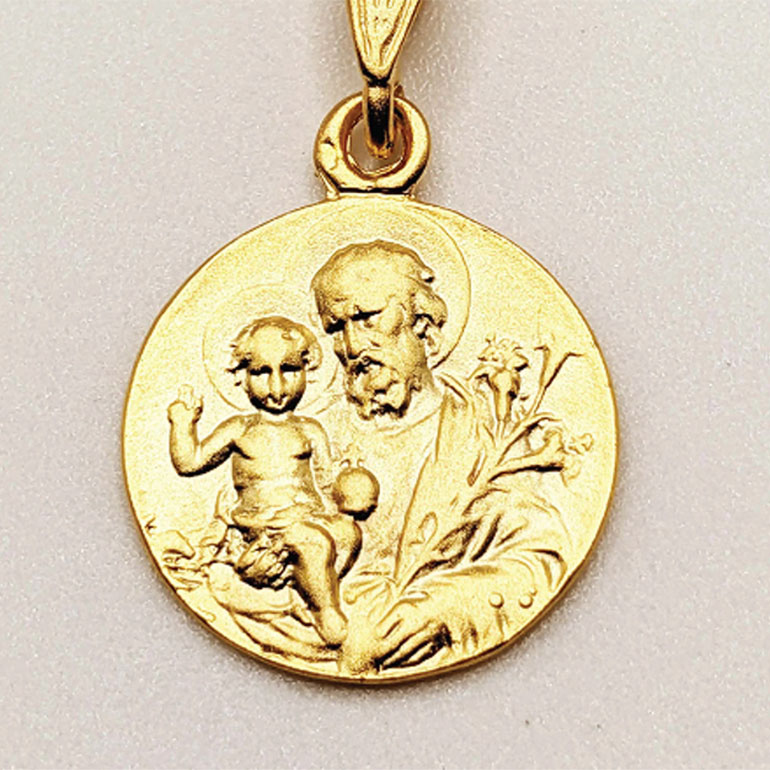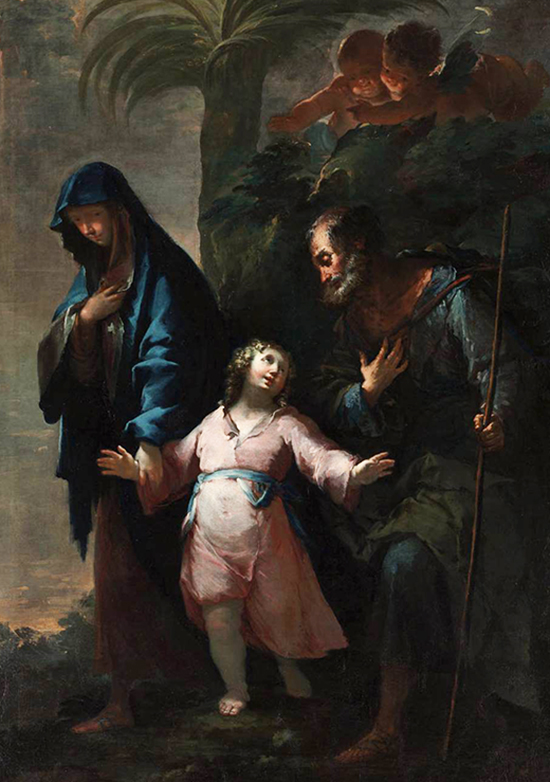March 19th is the feast of Saint Joseph, husband of the Blessed Virgin Mary, mother of Jesus. It is also Father’s Day in the Catholic countries of Spain, Portugal and Italy.
 Saint Joseph with the Infant Jesus by Guido Reni, c. 1635
Saint Joseph with the Infant Jesus by Guido Reni, c. 1635
Joseph, the carpenter from Nazareth in Galilee, was of the lineage of David through Abraham, and was the son of either Heli (Luke 3:23) or Jacob (Matthew 1:16). Joseph was a man of strong beliefs. He not only strove to do what was right but also to do it the right way.
The Bible pays Joseph the highest compliment: he was a “just” man. The quality meant a lot more than faithfulness in paying debts. When the Bible speaks of God “justifying” someone, it means that God, the all-holy or “righteous” one, so transforms a person that the individual shares somehow in God’s own holiness.
By saying Joseph was “just,” the Bible means that he was one who was completely open to all that God wanted to do for him. Joseph became holy by opening himself totally to God. This just man was joyfully and wholeheartedly obedient to God—in marrying Mary, in naming Jesus, in shepherding the precious pair to Egypt, in bringing them to Nazareth, and in his undetermined number of years of quiet faith and courage.
.

Abbaye de Saint-Victor Marseille
[Bouches-du-Rhône]
Saint-Joseph et l’enfant Jésus
Tableau du D Papety [1815-1849]
.
Joseph, the Man of Dreams
Joseph first appears in the Gospels of Matthew and Luke, both dating from around 80-90 AD. In Matthew, Joseph obeys the direction of an angel of the Lord to marry Mary.
 The Dream of St Joseph by Anton Raphael Mengs, 1728-1779
The Dream of St Joseph by Anton Raphael Mengs, 1728-1779
.
Matthew 1:18-25
18 This is how the birth of Jesus the Messiah came about: His mother Mary was pledged to be married to Joseph, but before they came together, she was found to be pregnant through the Holy Spirit.19 Because Joseph her husband was faithful to the law, and yet did not want to expose her to public disgrace, he had in mind to divorce her quietly.
20 But after he had considered this, an angel of the Lord appeared to him in a dream and said, “Joseph son of David, do not be afraid to take Mary home as your wife, because what is conceived in her is from the Holy Spirit. 21 She will give birth to a son, and you are to give him the name Jesus, because he will save his people from their sins.”
22 All this took place to fulfill what the Lord had said through the prophet: 23 “The virgin will conceive and give birth to a son, and they will call him Immanuel” (which means “God with us”).
24 When Joseph woke up, he did what the angel of the Lord had commanded him and took Mary home as his wife. 25 But he did not consummate their marriage until she gave birth to a son. And he gave him the name Jesus.
.
In Joseph’s first dream, it is the “angel of the Lord” who appears to him. After this heavenly visit he invariably awakes with total faith and no doubt whatsoever about its interpretation.
.
Joseph’s second dream
After Jesus was born in Bethlehem in Judea, during the time of King Herod, the Magi (three wise men) came from the east following the star to Jerusalem looking for the new born king of the Jews. King Herod heard this and was disturbed. Then he secretly called the Magi and sent them to Bethlehem telling them to search for the child and come back and report to him, “so that I too may go and worship him.”
The Magi continued to follow the star until it stopped over the place where the child was, and were overjoyed. They entered and saw the baby with his mother Mary, and they bowed and worshiped him and gave him their treasures of gold, frankincense and myrrh. And Having been warned in a dream not to go back to Herod, they returned to their country by another route.
.
Matthew 2:13
13 When they had gone, an angel of the Lord appeared to Joseph in a dream. “Get up,” he said, “take the child and his mother and escape to Egypt. Stay there until I tell you, for Herod is going to search for the child to kill him.”
.
So Joseph and Mary fled with Jesus into Egypt. They remained there until the death of Herod the great. All of this was to fulfill the prophecy found in Hosea 11:1, “Out of Egypt did I call my son.”
Historically Israel was the “son” and these words referred to God calling Israel out of Egypt (the exodus out of Egypt). God overcame the Pharoah and led His “Son” (His children) out of Egyptian oppression and slavery. So this statement was also a prophesy of the fact that God’s beloved Son would be called out of Egypt.
.
Joseph’s third dream
When the Magi did not return to Herod he was furious. He gave orders to kill all the boys in Bethlehem and the vicinity that were 2 years old and younger. Jeremiah’s prophecy was fulfilled: “A voice is heard in Ramah, weeping and great mourning. Rachel weeping for her children and refusing to be comforted, because they are no more.”
.
Matthew 2:19
19 After Herod died, an angel of the Lord appeared in a dream to Joseph in Egypt 20 and said, “Get up, take the child and his mother and go to the land of Israel, for those who were trying to take the child’s life are dead.”
.
Joseph arose from his dream and took Jesus and Mary out of Egypt into the land of Israel.
Joseph had heard that the wicked, ruthless Herod Archelaus was ruling Judea where his father, Herod the great, lived. Joseph was afraid to return to Judea because it would mean death for Jesus and possibly for he and Mary.
.
Joseph’s fourth dream
God warned Joseph in a dream not to go to Judea:
Matthew 2:22-23
1660 Apparition of Saint Joseph
On June 7th of 1660 Saint Joseph appeared to a shepherd of 22 years of age named Gaspard Ricard from Cotignac, France who was desperately thirsty while tending his flock. Gaspard saw a man on a rock that twice said, “I am Joseph, lift this rock and you will find drink.” Gaspard easily removed the rock and found a spring and drank from it. It would have taken a dozen men to remove the rock that Gaspard had raised alone. This was later the same year that King LOUIS XIV came to Cotignac. Many healings and miracles were attributed to the spring.
In 1661 the St. Joseph Sanctuary was started and King LOUIS XIV declared that from that time, March 19th (Saint Joseph’s day) would be a festival, free from work. He also consecrated the whole of his kingdom of France to St. Joseph, as did his father to Our Lady in February 1638 (King LOUIS XIII). The Sanctuary was consecrated in 1663. The Oratorian fathers took charge until the Revolution.
In 1792 in France there was dissolution of the religious communities and confiscation of the Church’s property. That was the end of pilgrimages for the XVIII century. In 1793 the two Sanctuaries had been declared “national property.” For two centuries following the French Revolution, the buildings of Bessillon were abandoned and fell into disrepair.
In 1977 fourteen Benedictine nuns arrived from Algeria looking for a place in which to live their contemplative life. They found St. Joseph and the ruined monastery. For several years they restored it. The nuns follow the RULE of ST. BENEDICT with its walls and cloisters overlooking the magnificent rolling hills of Provence towards the Mediterranean Sea.
 Source of St. Joseph
Source of St. Joseph
at Monastère de St. Joseph in Bessillon, France.
.
Saint Joseph is the patron saint of:
the Universal Church
unborn children
fathers
families
workers
travelers
immigrants
and a happy death
.
The Story of Saint Joseph the Worker
To foster deep devotion to Saint Joseph among Catholics, and in response to the “May Day” celebrations for workers sponsored by Communists, Pope Pius XII instituted May 1st as the feast of Saint Joseph the Worker in 1955. This feast extends the long relationship between Joseph and the cause of workers in both Catholic faith and devotion. Beginning in the Book of Genesis, the dignity of human work has long been celebrated as a participation in the creative work of God. By work, humankind both fulfills the command found in Genesis to care for the earth (Gn 2:15) and to be productive in their labors. Saint Joseph, the carpenter and foster father of Jesus, is but one example of the holiness of human labor.
.
Underground Real Estate Agent
There is a custom of burying a statue of St. Joseph in order to sell a home you place on the market. This custom goes back at least to the great St. Teresa of Avila (A.D. 1515 – 1582), foundress of the Disalced Carmelite Order. As her Order spread, a new convent had to be built, and in order for a new convent to be built, land must be had. When the nuns found a particular piece of land that was perfect for their purposes, they also found that their coffers weren’t full enough to purchase it, so they decided to ask the intercession of St. Joseph, burying medals imprinted with his likeness in the ground of the desired property as a sign of their prayers. It worked.
It also worked for Blessed Brother André Bessette, who was able to get the land on which he built the Shrine of St. Joseph of Mount Royal, in Montreal, Canada by praying to St. Joseph and burying a St. Joseph medal on the grounds of the future site as a sign of his prayers.
Now, both of these events deal with acquiring land, not selling it, and they deal with St. Joseph medals, not St. Joseph statues. Nonetheless, over time, the folk custom came to be for sellers of homes to bury a statue of St. Joseph as a sign of prayer asking to find a buyer and hasten the sale.
.
How to bury your St Joseph statue or medal
Most commonly, a statue of St. Joseph is placed inside a protective cloth and buried upside-down in the front yard facing the house. If you are burying a medal, place it face down.
Then you say a prayer to St Joseph asking him to help you in your efforts to find a buyer for your house. You remember to pray each day for St Joseph’s intercession until your house is finally sold.
When the house is sold, God and St. Joseph are thanked, the statue is dug up and given a place of honor in your new home, and you, of course, tell others about the power of St. Joseph’s intercession.







I visited the grotto and ceremonies years ago as a tourmember handled by Richard Gallagher(sp?) and Dr.Tim Mitchel out of NY City